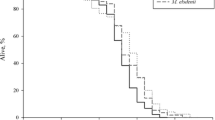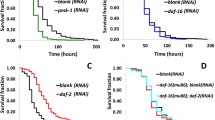Abstract
Lipopolysaccharide is one of the pathogen-associated molecular patterns of Gram-negative bacteria which are essential for its pathogenicity. Cronobacter sakazakii is an opportunistic, emergent pathogen, which infects and cause mortality in Caenorhabditis elegans. In this study, modifications in host and C. sakazakii LPS during infections were evaluated. The physiological assays revealed that LPS alone is sufficient to affect the host pharyngeal pumping rate, brood size and cause lethality. FTIR spectra of LPS revealed that C. sakazakii modifies its LPS to escape from the recognition of host immune system. These results indicate that LPS plays a key role in C. sakazakii pathogenicity. qPCR studies revealed that LPS modulated the expression of selected host immune (clec-60, clec-87, lys-7, ilys-3, F08G5.6, atf-7, scl-2, cpr-2) and aging-related genes (skn-1, clk-2, bra-2, age-1, bec-1, daf-16, daf-2). Moreover, it was confirmed that p38 MAPK pathway has a major role in host immune response against LPS-mediated challenges.










Similar content being viewed by others
Abbreviations
- CGC:
-
Caenorhabditis Genetics Center
- LPS:
-
Lipopolysaccharide
- MAPK:
-
Mitogen-activated protein kinase
- NGM:
-
Nematode growth medium
- O/N:
-
Overnight
- PCR:
-
Polymerase chain reaction
- Pmk :
-
P38 MAP kinase family
- RT-PCR:
-
Reverse-transcriptase polymerase chain reaction
- Sek :
-
SAPK/ERK kinase
References
Aballay A, Drenkard E, Hilbun LR, Ausubel FM (2003) Caenorhabditis elegans innate immune response triggered by Salmonella enterica requires intact LPS and is mediated by a MAPK signaling pathway. Curr Biol 13(1):47–52
Bannerman DD, Goldblum SE (1999) Direct effects of endotoxin on the endothelium: barrier function and injury. Lab Invest 79:1181–1199
Bowen AB, Braden CR (2006) Invasive Enterobacter sakazakii disease in infants. Emerg Infect Dis 12:1185–1189
Brenner S (1974) The genetics of C. elegans. Genetics 77:71–94
Ciornei CD, Novikov A, Beloin C et al (2010) Biofilm-forming Pseudomonas aeruginosa bacteria undergo lipopolysaccharide structural modifications and induce enhanced inflammatory cytokine response in human monocytes. Innate Immun 16(5):288–301
Darby C (2005) Interactions with microbial pathogens. WormBook http://www.wormbook.org. Accessed 6 Sept 2005
Drudy D, Quinn NR, Wall PG, Fanning S (2006) Enterobacter sakazakii: an emergent pathogen in powdered infant formula. Clin Infect Dis 42:996–1002
Dubois M, Gilles KA, Hamilton JK et al (1956) Colorimetric method for determination of sugars and related substances. Anal Chem 28:350–356
Dumen E (2010) Cronobacter sakazakii (Enterobacter sakazakii): only an infant problem? Kafkas Univ Vet Fak Derg 16:S171–S178
Erickson MC, Kornacki JL (2002) Enterobacter sakazakii: an emerging food pathogen. Acedido em Fev 25:2008
Irazoqui JE, Urbach JM, Ausubel FM (2010a) Evolution of host innate defence: insights from Caenorhabditis elegans and primitive invertebrates. Nat Rev Immunol 10(1):47–58
Irazoqui JE, Troemel ER, Feinbaum RL et al (2010b) Distinct pathogenesis and host responses during infection of C. elegans by P. aeruginosa and S. aureus. PLoS Pathog 6(7):e1000982
Iversen C, Lehner A, Mullane N et al (2007) The taxonomy of Enterobacter sakazakii: proposal of a new genus Cronobacter gen. nov. and descriptions of Cronobacter sakazakii comb. nov. Cronobacter sakazakii subsp. sakazakii, comb. nov., Cronobacter sakazakii subsp. malonaticus subsp. nov., Cronobacter turicensis sp. nov., Cronobacter muytjensii sp. nov., Cronobacter dublinensis sp. nov. and Cronobacter genomospecies I. BMC Evol Biol 7:64
Kesika P, Pandian SK, Balamurugan K (2011) Analysis of Shigella flexneri mediated infections in model organism Caenorhabditis elegans. Scand J Infect Dis 43(4):286–295
Kim JB, Cho SH, Park YB et al (2008) Surveillance of stool samples for the presence of Enterobacter sakazakii among Korean people. Yonser Med J 49:1017–1022
Maclean LL, Vinogradov E, Pagotto F et al (2010) The structure of the O-antigen of Cronobacter sakazakii HPB 2855 isolate involved in a neonatal infection. Carbohydr Res 345(13):1932–1937
Mange JP, Stephan R, Borel N et al (2006) Adhesive properties of Enterobacter sakazakii to human epithelial and brain microvascular endothelial cells. BMC Microbiol 6:1–10
Moser SC, von Elsner S, Bussing I et al (2009) Functional dissection of Caenorhabditis elegans CLK-2/TEL2 cell cycle defects during embryogenesis and germline development. PLoS Genet 5(4):e1000451
Mullane N, Gaora PO, Nally JE et al (2008) Molecular analysis of the Enterobacter sakazakii O-antigen gene locus. Appl Environ Microbiol 74:3783–3794
Murphy K (2012) Innate immunity: the first lines of defense. In: Murphy K (ed) Janeway’s Immunobiology, 8th edn. Garland Science, New York, pp 37–73 (Chapter 2)
Ohno N, Morrison DC (1989) Lipopolysaccharide interaction with lysozyme. Binding of lipopolysaccharide to lysozyme and inhibition of lysozyme enzymatic activity. J Biol Chem 264(8):4434–4441
Olson NC, Hellyer PW, Dodam JR (1995) Mediators and vascular effects in response to endotoxin. Br Vet J 151:489–522
Ooi SK, Lim TY, Lee SH, Nathan S (2012) Burkholderia pseudomallei kills Caenorhabditis elegans through virulence mechanisms distinct from intestinal lumen colonization. Virulence 3(6):485–496
Papp D, Csermely P, Soti C (2012) A Role for SKN-1/Nrf in pathogen resistance and immunosenescence in Caenorhabditis elegans. PLoS Pathog 8(4):e1002673
Pradel E, Zhang Y, Pujol N et al (2007) Detection and avoidance of a natural product from the pathogenic bacterium Serratia marcescens by Caenorhabditis elegans. Proc Natl Acad Sci USA 104(7):2295–2300
Rubenstein HS, Fine J, Coons AH (1962) Localization of endotoxin in the walls of the peripheral vascular system during lethal endotoxemia. Proc Soc Exp Biol Med 111:458–467
Sharifi AM, Hoda FE, Noor AM (2010) Studying the effect of LPS on cytotoxicity and apoptosis in PC12 neuronal cells: role of Bax, Bcl-2, and Caspase-3 protein expression. Toxicol Mech Methods 20(6):316–320
Sivamaruthi B, Balamurugan K (2014) Physiological and immunological regulations in Caenorhabditis elegans infected with Salmonella enterica serovar Typhi. Indian J Microbiol 54(1):52–58
Sivamaruthi BS, Ganguli A, Kumar M et al (2011) Caenorhabditis elegans as a model for studying Cronobacter sakazakii ATCC BAA-894 pathogenesis. J Basic Microbiol 51:240–249
Thimmulappa RK, Lee H, Rangasamy T et al (2006) Nrf2 is a critical regulator of the innate immune response and survival during experimental sepsis. J Clin Invest 116(4):984–995
Townsend S, Hurrell E, Forsythe S (2008) Virulence studies of Enterobacter sakazakii isolates associated with a neonatal intensive care unit outbreak. BMC Microbiol 8:1–9
Vigneshkumar B, Pandian SK, Balamurugan K (2012) Regulation of Caenorhabditis elegans and Pseudomonas aeruginosa machinery during interactions. Arch Microbiol 194(4):229–242
Wilson JW, Schurr MJ, LeBlanc CL et al (2002) Mechanisms of bacterial pathogenicity. Postgrad Med J 78(918):216–224
Yi EC, Hackett M (2000) Rapid isolation method for lipopolysaccharide and lipid A from Gram-negative bacteria. Analyst 125(4):651–656
Acknowledgments
We thank Caenorhabditis Genetics Center, which is funded by the National Institutes of Health, National Center for Research Resources for providing C. elegans N2 WT, mutant strains and E. coli OP50. KB thankfully acknowledges the Department of Biotechnology (DBT), University Grand Commission (UGC), Indian Council of Medical Research (ICMR) and Council of Scientific and Industrial Research (CSIR), Department of Science and Technology (DST), Government of India, New Delhi, India, for the financial assistances. BS wishes to thank DBT and CSIR, India, for the financial assistance (DBT-JRF & CSIR-SRF). The authors also gratefully acknowledge the use of the Bioinformatics Infrastructure Facility, Alagappa University funded by the Department of Biotechnology, Ministry of Science and Technology, Government of India (No. BT/BI/25/001/2006).
Conflict of interest
The authors declare that they have no conflict of interest.
Author information
Authors and Affiliations
Corresponding author
Additional information
Communicated by Erko Stackebrandt.
Rights and permissions
About this article
Cite this article
Sivamaruthi, B.S., Prasanth, M.I. & Balamurugan, K. Alterations in Caenorhabditis elegans and Cronobacter sakazakii lipopolysaccharide during interaction. Arch Microbiol 197, 327–337 (2015). https://doi.org/10.1007/s00203-014-1064-1
Received:
Revised:
Accepted:
Published:
Issue Date:
DOI: https://doi.org/10.1007/s00203-014-1064-1




